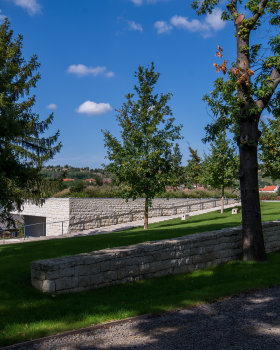查看完整案例


收藏

下载
米兰,4月8日 – 米兰设计周期间,MAD建筑事务所公布为Scali Milano项目所作的整体规划研究方案“历史性的未来:米兰,再生”(Historical Future: Milan Reborn)。Scali Milano由米兰市政府及FS城市系统 (FS Sistemi Urbani)发起,全球范围内邀请了包括MAD在内的五家国际建筑事务所 (另外四家为Stefano Boeri Architetti, Mecanoo architecten, MIRALLES TAGLIABUE EMBT, Cino Zucchi Architetti),针对米兰Scali地区废弃失修的铁路区域进行改造重建研究。MAD以“通达化城市”、“绿色城市”、“生活化城市”、“文化城市”、“资源化城市”五大要素为切入方向,期望最终将废弃片区转化成活跃的具有社会属性的景观建筑,将米兰市民、米兰大都会地区以及自然环境有机、和谐融合,成为更活跃、更接合的新型社区。
April. 8th, Milan – MAD Architects presents their research proposal Historical Future: Milan Reborn for the Scali Milano project, community-reactivation masterplan research headed by FS Sistemi Urbani (FS Urban Systems) and Comune di Milano (the Municipality of Milan) with the support of Regione Lombardia (Lombardy Region). MAD Architects, along with four other international architecture firms (Stefano Boeri Architetti, Mecanoo Architecten, MIRALLES TAGLIABUE EMBT, and Cino Zucchi Architetti), was invited to envision a series of Milan’s dilapidated railyards as productive social landscapes that establish a harmony between Milan’s citizenry, the larger metropolitan region, and the natural environment. MAD proposes that these railyards become interconnected micro-systems conforming to five spatial concepts: “City of Connections,” “City of Green,” “City of Living,” “City of Culture,” and “City of Resources.”
米兰位于地中海轴线及莱茵阿尔卑斯轴线的交汇核心,在欧洲的地理、经济上拥有无可比拟的的核心地位。自上世纪中以来,Scali Milano所辖的多个铁路区域开始处于长期废弃状态。Scali旧城的改造重建将会是兰巴蒂(Lombardy)城区、米兰大都会地区活化城市脉络、激活城市能量的重中之举。米兰市政府希望通过旧城改造整体规划,使米兰升级成为具备全球竞争力的世界级城市,在更高密度城市条件下满足人口增长需求、实现便利的未来交通规划、混合和临时的可持续发展等愿景。去年12月,MAD与其他四家国际事物所一同参与了由市政府、FS城市系统牵头,城市规划官员、学者、市民、建筑师共同参与的为期三天的工作坊。
The railyards, essential objects of the Scali Milano research, have been in varying states of disuse since the last century. The repurposing of the railyards represents an important part of the Lombardy Region’s, and the larger Italian Metropolitan Region’s, urban discourse that the city of Milan can uniquely address. Central to this discourse is the integration of the fabric of the old city into part of a holistic plan that can address and celebrate population growth as the city continues to densify, through the introduction of additional mass transit infrastructure, affordable housing typologies, and sustainable mixed-use development.
Last December, MAD participated in a three-day open workshop, led by FS Sistemi Urbani (FS Urban Systems), Comune di Milano (the Municipality of Milan) and Regione Lombardia (Lombardy Region) with Milan’s citizenry, planning officials, academics, and architects. Using research from these workshops, the seven research studies in MAD’s Historical Future: Milan Reborn emphasize the competitive global design capital’s situation within the intersection of the contemporary “Rhine-Alpine Corridor” and the “Mediterranean Corridor,” as well as its place within a broader, and global, metropolitan network.
▼ MAD研究的七个废弃铁路区域与米兰关系图,analysis of the relationship between seven abandoned railyards and the city of Milan
Scalo Farini
坐落在米兰西北角的Scalo Farini,拥有着最大的铁路系统面积(61.8万平方米),尽管其地理位置极其重要——未来将通过地铁及绕城火车线实现将周围片区与米兰市区连接,但现今只是一片废墟。MAD改造后的Scalo Farini将从生活的层面改变现实,成为属于人们的拥有多种业态的绿色城市景观型社区:原本废弃的U型火车上落站将被打开成为广阔的公共空间,三处由商业、住宅混合而成的微型社区分布其中。社区、社区公共空间及绿色公园彼此间保持着恰如其分但又可顺利通达的距离。绿色公园边上的社会住宅以及两座综合体高层与片区核心相互呼应。
Having the largest total land area of the railyards (618,733 sqm), and situated in north-western Milan, Scalo Farini and Valtellina offers extraordinary connectivity to the Central Business District and the larger city through an upcoming M5 underground line development. Farini and Valtellina’s proposal is organized as a topographic civic landscape with a gradient of housing typologies situated around its boundary, designed to reactivate the site as an organic community that reconciles the congestion of the inner city with the tranquility of a rural environment.
At the site’s center, three “villages,” dense aggregations of residential, commercial, and public development, are grafted into the landscape around a repurposed freight warehouse, which houses a mixture of civic resources. An organizational nexus, the freight warehouse unifies the scales and programs of the design proposal, as well as an internal system of pedestrian and cycling paths that connect Scalo Farini and Valtellina to its urban context. Social housing developments, emulating traditional Italian courtyard residences, sit in dialogue with two contoured, mixed-use towers rising from a repurposed plinth adjacent to the Porta Garibaldi train station.
Porta Genova
位于米兰东南部的Porta Genova,以国际时尚、文化品牌总部驻地而闻名。MAD将中间狭长的空档转化成展览、表演的公共空间,使人们能够偶尔跳出繁忙的工作去接触、欣赏文化与艺术。MAD希望通过插入与片区属性一致的微型元素,连接本来隔断不通达的两个片区,使其成为具有文化、艺术属性的有机整体。
Located in south-eastern Milan along the Naviglio Grande, Scalo Porta Genova is situated in a local context long-supporting fashion and culture industries, and has been primarily designed to host pavilions for events, performances, and markets that encourage social interaction. As an extension of the activities that give identity to its context, the proposal encourages at the same time a renewed relationship with the demands of commerce at an international scale.
The diagrammatic approach used in Historical Future: Milan Reborn addresses a vernacular development typical of Italian cities, where various typological elements and scales are overlapped into dense systems of relations. Designing first at the human scale within recognizable landmarks, the broader urban scale is connected to smaller ones through the interjection of topographic landscapes, serving to unify the continually changing relations of the pedestrian, city, and nature. Each of the yards, following the necessities of their adjacent neighborhoods, will thus take on new lives and functions within their sites’ dense histories.
MAD同时也对另外五个铁路区域(Scalo San Cristoforo, Scalo Rogoredo, Scalo Lambrate, Scalo Greco-Breda, and Scalo Porta Romana))作了详尽研究方案报告。Scali Milano整体规划研究方案展览于4月4日至9日间于米兰设计周期间展出。
MAD also presents their research proposals for five other railyard areas: Scalo San Cristoforo, Scalo Rogoredo, Scalo Lambrate, Scalo Greco-Breda, and Scalo Porta Romana. The seven proposals of Historical Future: Milan Reborn, along with those of the four other teams participating in the Scali Milano initiative, are being publically displayed during Milan Design Week, from the 4th-9th of April, 2017.
▼ 马岩松和米兰市长,Ma Yansong with the mayor of Milan
历史性的未来:米兰,再生
2016-2017
意大利米兰
展览地点:Fondo Corsa Passerella Biki Porta Genova
展览日期:2017年4月4-9日
类型:整体规划
铁路区域总面积:1247605平方米
主持建筑师:马岩松、党群、早野洋介
副合伙人:Andrea D’Antrassi
设计团队:何威,刘海伦,MarcoGastoldi, Dmitry Seregin, Felix Amiss, 舒赛, Edoardo Nieri, 黄耀俊, Jacques Maria Brandt, Ares Andrea Martorelli
Historical Future: Milan Reborn
2016-2017
Milan, Italy
Exhibition Location: Fondo Corsa Passerella Biki Porta Genova
Exhibition Date: April 4-9, 2017
Typology: Masterplan
Total Railyard Area: 1,247,605 sqm
Directors: Ma Yansong, Dang Qun, Yosuke Hayano
Associate Partner in Charge: Andrea D’Antrassi
Team: HE Wei, Helen Liu, Marco Gastoldi, Dmitry Seregin, Felix Amiss, SHU Sai, Edoardo Nieri, HUANG Yaojun, Jacques Maria Brandt, Ares Andrea Martorelli






































